les Nouvelles May 2018 Article of the Month
SME Case Studies On IP Strategy And IP Management—Releasing Untapped Value
By Guest editors of the les Nouvelles SME case study special issue
EPO, European Patent Academy, Innovation Support Programme
Area Manager
Munich, Germany
EPO, Chief Economist Unit
Chief Economist
Munich, Germany
EPO, Chief Economist Unit
Senior Economist
Munich, Germany
Abstract
This article introduces the SME case studies which are the focus of this special issue. It provides an overview of the companies involved, and looks at the main conclusions drawn by the studies on how to address the common challenges of IP strategy and management faced by SMEs. It also gives trainers suggestions on how to integrate the case studies into their training offer.
Introduction
Small and medium-sized companies (SMEs)1 are the backbone of the European economy. In the 28 member states of the European Union (EU), there are more than 21 million SMEs, representing about 99.8 percent of all businesses and employing 66.8 percent of the working population.2 They include hundreds of thousands of SMEs from high-tech and growth industries, in which patents play an important role.
In 2016, 28 percent of all patent applications filed with the European Patent Office (EPO) came from SMEs, showing that they are important drivers of European innovation. The Intellectual Property SME Scoreboard 2016 study3 conducted by the EUIPO revealed that the majority of SMEs consider themselves to be innovative, although only nine percent of European SMEs register IP rights (IPRs). However, before they can consider protecting their IP assets, companies need to understand how to derive economic benefits from them and how to use IP strategy to define how IP should support their business. Understanding the required IP management processes and tools, companies can employ their intellectual capital efficiently.
The Intellectual Property SME Scoreboard 2016 indicates that many SMEs do not know how to incorporate IP protection into their business strategy. They are often put off by the investment required, as well as by the need to take IP-related decisions for the longer term. Their ability to use IP to their advantage often does not match that of larger companies. It is therefore important to make them aware that IP can be a major contributor to their business success.
Considering the limited resources these small businesses have at their disposal, well-designed and easyto- access training is a must if they are to acquire the information and know-how they need. The services of the European Patent Academy, the external education and training arm of the European Patent Office, are tailored to the practical needs of SME executives and R&D staff, taking into account their considerable time constraints, and keeping the entry barriers to training and training material as low as possible.
As there is already a wealth of training offers for SMEs, the Academy focuses on bridging identified gaps. Case studies are one of the best ways to do this, by extracting knowledge from individual cases, it is possible to draw generally applicable conclusions about how to address common challenges.
Objectives of the SME Case Study Series
The SME case studies are intended to fill a gap in current IP literature. There is a lack of specific, up-todate examples showing how technology-focused SMEs can use IP effectively to support their business models. 4 The SME case studies therefore aim to:
- Provide an understanding of the various ways in which SMEs can profit from patents and create value (protect key products, support the formation of licensing partnerships, facilitate funding, tax benefits).
- Communicate good practices in IP strategy and management (awareness and involvement at senior management level, early capture of IP, timely involvement of IP experts, pragmatic and innovative use of the flexibility offered by IP).
- Facilitate the transfer of knowledge of IP strategy and management by presenting concrete business examples supplemented by complementary training products (presentation slides with speaking notes, training courses based on the studies, translations) and by creating a pool of IP experts and SMEs available for future dissemination activities.
Overview of Selected Companies
The role of IP changes as a company moves through the different stages in its commercial life. The nature of its benefits depend strongly on the company's business model, the IP ecosystem it operates in and the market mechanisms at play.
The 12 SMEs selected for the case studies have been chosen to reflect this diversity. They originate from different parts of Europe (see Figure 1) and operate in a wide variety of technology fields, ranging from medical technology to special machinery (see Table 1). They are also broadly diverse in terms of their business cases and stages of development. They range from Orcan Energy, a university spin-off with a product sales-oriented business model,5 to Fractus, an older company that had to reinvent its business model to become more licensing-oriented (see Figure 2).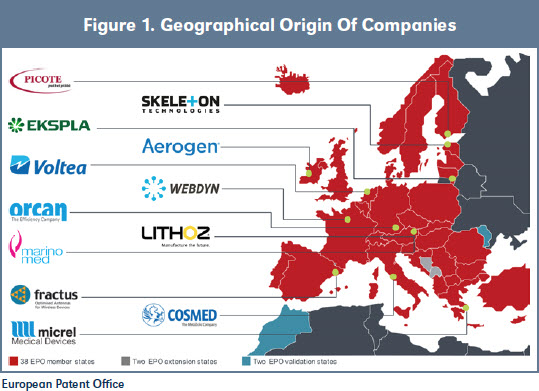
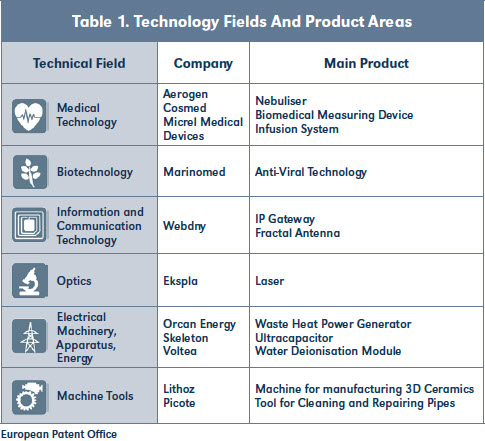
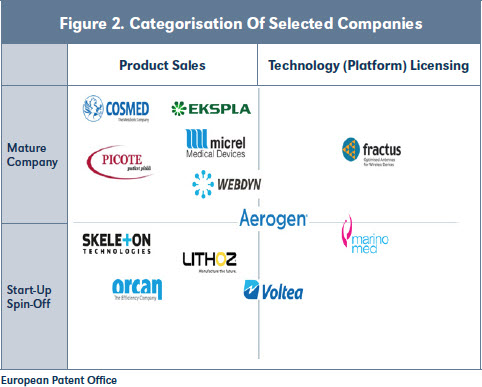
The case studies have been produced by the EPO together with IP specialists selected on the basis of their expertise in the areas of IP strategy and management and the European patent system and their experience of advising emerging SMEs.
Main Findings
The overarching outcome emerging from the case studies is that IP rights are strategic assets that can bring more to SMEs than merely a costly insurance against imitation. SMEs can use patents not only to protect their products and support their freedom to operate, but also to increase the value and improve the image of the company and its products. They can also use IP to establish and facilitate co-operation with other companies in the development and commercialisation stages, attract investors and, where regulatory approval is required, protect the additional investments involved.
The role of patents and other IP rights can change over time. IP strategy and management have to develop along with the company, supporting it as it evolves from a start-up to a more mature enterprise. A strong patent portfolio, for example, allows companies to diversify by applying a dual business model and lets them generate revenues from direct product sales as well as technology licensing.
The studies also show that business intelligence derived from patent information is essential to effective IP management. Prior art searching, freedom to operate and infringement determination, and competitor monitoring are central to all strategic IP and business decisions.
These findings are in broad agreement with the Intellectual Property SME Scoreboard 2016 study,2 which looked at why SMEs in the European Union use IP rights.
Based on the findings of the SME case studies, the following recommendations can be made:
Recommendations for IP Strategy
- Make critical IP monetisation decisions, taking into account long-term consequences, an integral part of your IP strategy.
- Create an IP strategy which is:
- pro-active and aligned with your business case.
- based on corporate vision.
- able to safeguard investment and reduce risks.
- put into effect at an early stage of product development.
- streamlined with R&D.
- adjusted to the current phase of evolution of your company.
- responsive to market conditions.
- implemented at senior management level and regularly refined by experts.
- never fully outsourced.
- incorporating non-financial costs and benefits (e.g. image, goodwill).
- reviewed on a regular basis.
- Make IP monetisation in all possible forms an integral part of your company's value-creation process.
- Use patent portfolios to transform or extend existing business models.
- Be prepared to enforce your rights and even litigate, if necessary.
- Collaborate with external research centres to perform knowledge transfer and early-stage research at a reasonable cost in order to develop new patentable technologies.
- Keep technology development roadmaps, products, services and IP protection aligned.
- Use IP acquisition or in-licensing to broaden your technology and market base and close gaps in the IP portfolio.
- Remember that even minor improvements can be worth patenting. Market needs and environment dictate what is commercially relevant and worth protecting.
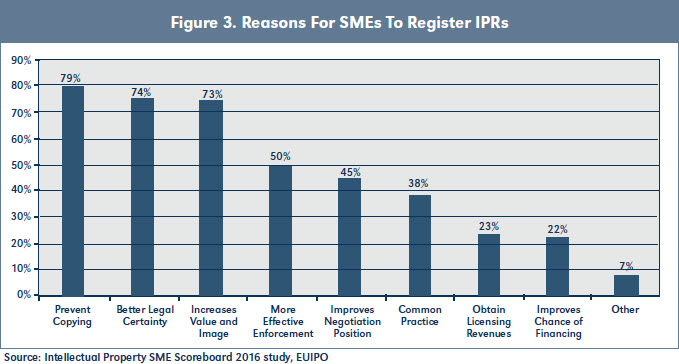
Recommendations for IP Management
- Take a holistic approach to IP management and involve all relevant internal stakeholders in the planning.
- Integrate in-house IP specialists into the core team.
- Give employees incentives and the freedom to pursue their own ideas.
- Use the support of external IP expertise where necessary and appropriate.
- Adapt your filing strategy to your real business needs.
- Focus on the quality rather than the quantity when building a patent portfolio.
- Create a financial plan that accounts for the rising increase in costs as a patent portfolio matures.
- Consider cross-licensing as a means to secure free- dom-to-operate.
- Use patent information to search for prior art, assess freedom to operate and determine infringement.
- Set up a process to monitor technology and com- petitors.
- Consider patents and other IP rights as comple- mentary.
- Take advantage of tax benefits connected with pat- ents and R&D.
- Train your innovation team to use patent search tools.
- Make use of information from customers, resellers and suppliers to detect infringement.
- Assign dedicated staff to supervise IP management actions.
- Keep up-to-date with changes and developments in the patent system.
- Have a clear agreement on co-operation with other companies. Try to avoid joint patent ownership if not clearly regulated.
- Review your patent portfolio on a regular basis to manage costs.
- Use innovation workshops to help capture IP sys- tematically.
- Conduct prior-art searches before embarking on R&D.
The case studies shed light on the specific challenges faced by SMEs in the current European patent system. However, the perspective goes beyond that. Taking into account future developments, they highlight the expected benefits of the forthcoming Unitary Patent package for SMEs. These include savings in time and money, as well as increased legal certainty across the EU market. This reform will offer businesses a sim- pler alternative to the existing system, and introduce a more cost-effective route to broad and uniform patent protection and dispute resolution throughout the par- ticipating EU member states. Most SMEs currently focus on a few larger EU states to reduce post-grant pat- ent fees and administrative costs. The Unitary Patent might help SMEs to better leverage their IP in the EU.6
Main Findings of the Individual Case Studies
Aerogen—Breathing New Life Into Aerosol Drug Delivery
When a company transforms from a small start-up to a global leader in aerosol technology for drug delivery in acute care, its strategic partners must be able to rely on the quality and protection of the products on offer. Key to addressing this challenge is a strong patent port- folio protecting both the core technology as well as a diverse range of product applications.
- Customers, investors and partners consider it very important for a young company to have strong IP.
- Company scale-up must go hand in hand with IP portfolio-building.
- To successfully commercialise innovative technolo- gies, IP strategy must be clearly laid out and closely aligned with other key business functions.
- Competitor watches and patent searches are essential components of IP management.
Cosmed—At the Cutting Edge of Cardiopulmonary Diagnostics
This medical device company is founded on sound IP. Sound IP increases visibility and recognition, facilitates co-operation with partners and justifies premium prices. Establishing IP early in the process safeguards investment in R&D and offers protection from imitation until compliance with regulatory standards is achieved.
- It is essential to take both internal and external influences on the patent portfolio into account.
- In-depth prior art searches must be conducted early in the creative process and then professionally verified during the patenting procedure.
- External expertise and support is important for obtaining feedback on IP strategy and implementing strategic choices.
- When creating and maintaining an IP portfolio, it is vital to keep costs down without sacrificing quality.
Micrel Medical Devices—Smart Infusion Pumps for Treating Patients at Home
As a medical technology company, Micrel uses patents and patent information strategically to safeguard future product lines, ensure freedom to operate and find inspiration for new technical developments.
- Continuous innovation supported by patents allows technology-based SMEs to compete with large companies.
- Patent protection can help safeguard investments and reduce risk when introducing new products to the market.
- Well-thought-out filing strategies enable companies not only to speed up the granting process but also to postpone decisions where needed.
- Regular searches in patent databases allow companies to monitor competitors and reveal opportunities for future innovations.
Marinomed—Using Red Algae to Fight the Flu
As a drug discovery company, Marinomed relies heavily on patents. Its inventions are validated in almost 100 countries. The company actively manages and enforces its IP portfolio, which also includes some trademarks. Exploitation of its IP is based on two main licensing models.
- Flexible licensing models increase the chances of creating win-win situations.
- Involving an IP specialist early in the R&D stage can improve patent protection for subsequent commercial applications.
- Negotiation is the preferred way to solve potential infringement issues; litigation is regarded as a last resort.
- Trademarks can add value to patents and extend protection beyond the life of the patent.
Webdyn—Integrating ICT Creates Solutions for the Internet of Things
Working on the Internet of Things, the company profited from a pending patent application, using it as an asset when negotiating freedom to operate for some of its business.
- Patents can be used to secure freedom to operate, for example by means of cross-licensing agreements.
- They can contribute value when developing a marketing strategy.
- Options to postpone decisions in the patenting process can be used strategically in order to gain time or to optimise procedural and validation costs.
- Even pending patents can contribute a significant business value.
Fractus—Snowflake Pattern Precipitates New Application for Antennae
Fractus, a producer of antennae, has built its business success on licensing its patented technology. Its robust IP portfolio and its commitment to enforcing its rights strengthen its position in licensing negotiations and safeguard further R&D investments.
- A proactive, long-term IP strategy which is consistent with the overall corporate vision is essential.
- A patent portfolio based on continuing R&D allows companies to focus on technology licensing and helps secure financing.
- Litigation is a last but important resort when it comes to fighting wilful infringement.
- The Unified Patent Court (UPC) has the potential to remove the disadvantages of the current fragmented European litigation system.
Ekspla—Leveraging IP: From Research Tools to Industry Applications
IP protection helped Ekspla to enter the market for industrial laser applications and take part in publicly funded international projects. Ekspla engages in joint patenting with its partners and combines patents with trade secrets where appropriate.
- IP strategy and management skills can help overcome the challenges presented by business model changes.
- Patents can be used to shape a company´s technology competency profile.
- Combining trade secrets and patents can be a cost-efficient and effective way to protect IP.
- Joint ownership of a patent is an acceptable option if there is a clear agreement benefiting both parties.
Orcan Energy—Recycling Waste Heat to Cool Down the Planet
This former university spin-off sells standard components for heat power generators that recycle waste heat by turning it into electricity. Early acquisition of university patents was vital in order to attract funding. Orcan co-operates with other companies, but simplifies its patent management by avoiding joint ownership.
- University spin-offs need access to the relevant IP early on.
- Patent attorneys must understand the invention and the company's business case.
- Patents help to communicate a company's technical advantage and innovation skills.
- Access to joint inventions without joint patent ownership can be achieved using cross-licensing agreements.
Skeleton—Graphene Draws on Capacity for Energy Storage
As a producer of advanced materials for energy storage, Skeleton knows that it needs a strong patent portfolio if it is to keep on improving its technology and expanding its market. Employees at Skeleton are crosstrained so that everyone can support the IP strategy and its alignment with the company's R&D efforts.
- It is important from the outset for IP strategy to evolve together with business strategy.
- Providing all innovation team members with up-todate IP knowledge and bringing in external expertise will contribute to the quality of a company's IP portfolio and improve efficiency.
- Intelligence from patent information can be used for R&D and IP creation purposes.
Voltea—Capacitance Creates a Watershed in Purification
Obtaining patents for its water-softening and deionisation technology enabled Voltea to spin out from a larger company. The patents helped it to attract investors, set up co-operation with partners, and ultimately establish itself as a leader in the field.
- Strong patents aligned with a company's products help secure exclusivity in core markets.
- IP strategy should evolve with company development, with IPRs contributing in different ways at different stages.
- Patents can help establish commercial partnerships which provide additional funding, R&D support and new business networks.
- A holistic approach to IP management means constantly developing new and advanced skills and tools.
Lithoz—3D Printing Opens a New Chapter for Ceramics
University-owned patents created the springboard for this spin-off to enter the market for 3D-printed ceramics in industrial applications. Measures stimulating the creativity of staff and research partners yield new and patentable ideas, supporting the build-up of the company's patent portfolio and strengthening its market position.
- A university's IP strategy can have a big impact on the success of any spin-off.
- It is good practice to have dedicated IP managers who take IP issues into account in the course of the company's day-to-day business.
- An open climate can foster employees' creative ideas and channel them into successful projects.
- Even minor technical improvements can meet a market need and be worth patenting.
Picote—Pipe Repairs that Break the Rules but Not the Walls
This traditional construction and renovation contractor expanded its activities to include the development of mechanical solutions. The decision to patent these solutions meant that sales of the resulting products, which are in part easy to copy, now play a major role in the company's success.
- Patents can help expand a service company's business model to include high-value products.
- Customers and resellers can provide important information about infringement which can be used to enforce patent rights.
- Integrating IP experts into the core team can help streamline IP management processes and make them more efficient.
- Customer input and IP landscaping can provide vital stimulus for future innovation.
How to Use the Case Studies for Training Purposes
Learning on the basis of case studies allows participants to link theory to practice. The examples in the SME case studies demonstrate that SMEs from a wide range of backgrounds face similar challenges when it comes to commercialising their IP. The best way to get this information across is by means of authentic peerto- peer communication, in which experienced SMEs or IP consultants tell other SMEs how they succeeded.
Embedded in the normal training environment, case studies remove the focus from the trainer and place it on the trainees, who apply what they know, interact with each other and develop new ideas for managing IP and creating value. Trainee-centred didactics are a well-known method of improving levels of understanding and recall. They further critical thinking, strengthen analytical skills and help develop decision-making abilities. This is crucial for SMEs, as there is no "one size fits all" solution for IP strategy and management. In addition, the stakeholders involved provide diverse insights from a legal, marketing, technical and strategic perspective. All this contributes to a comprehensive discussion of IP.
There are several approaches to integrating case studies into training. The following approach focuses on using the SME case studies to deliver a formal training course in a classroom setting. The trainer can distribute a case study to trainees in advance, drawing their attention to the points which will be discussed at the actual training event. He or she may choose to divide the participants into groups. Each group is assigned one of the discussion points, and the conclusions will be reported on a flipchart or board by a group representative. If there is enough time available, the trainer or participants may present the take-away messages of the case studies. Alternatively, the trainer can simply draw the participants' attention to them. The training course could include material from other presentations, e.g. slides from the IP Teaching Kit—IP Management.7 This will help put the training into context, as well as provide additional tips and tools for IP management.
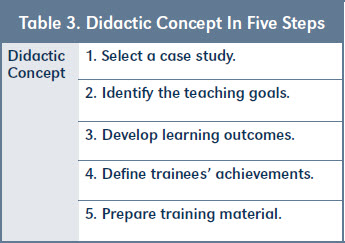 The following section describes how to develop a tailored didactic concept for discussing the issues based on the case studies (see Table 3). The concept is made up of five steps.
The following section describes how to develop a tailored didactic concept for discussing the issues based on the case studies (see Table 3). The concept is made up of five steps.
Step 1: Select a Case Study
Depending on the kind of training, identify the case study with the best match regarding the main technical field, business model, key messages, geographical origin and expertise of the trainer.
Step 2: Identify the Teaching Goals
Identify teaching goals specific to the chosen case study and look for facts and descriptions that serve to illustrate:
- The company's business model. In particular, what are the characteristics of the company's business environment?
- How the company formulates its IP strategy. In particular, how does it create value through achieving a competitive advantage and financial benefits?
- How it manages its IP. In particular, how does it build an IP portfolio, and how does it protect its products/services and underlying technology in Europe?
Create a link between the aims of the training and the identified teaching goals, and, in turn, the underlying critical business decisions, business strategy, requirements and events (external and internal) that have influenced the decisions of the SME in creating and managing IP.
Step 3: Develop Learning Outcomes
Describe the main findings (takeaway messages) and compile questions that will motivate participants to identify and analyse these takeaway messages and discuss alternative options that the company might have chosen, or could choose in the future.
Step 4: Define the Trainee's Achievements
Optimal learning outcomes will enable trainees to:
- Identify the competitive advantages and financial benefits a company can derive from creating and monetising an IP portfolio.
- Illustrate the steps a company can use to formulate an IP strategy.
- Formulate approaches and processes, and suggest tools that a company can use to build and manage an IP portfolio.
- Propose possible future risk-benefit scenarios for obtaining patent protection in Europe.
Step 5: Prepare Training Material
Create slides based on the following:
- Briefly describe the teaching goals.
- What did the SME do?
- What was the benefit?
- What other actions could have been taken?
- Are there additional steps that would have been necessary if they had pursued a different course?
- How would this have affected the results?
- What might the scenario have been if no action had been taken?
Outlook
Presentations combining supplementary material with a training concept developed in accordance with the five stages described above will be published by the EPO soon for selected case studies.
In addition, an interview guide for trainees will be envisaged. After reading the case study, and using the interview guide, trainees enact a role-play situation where one trainee is the interviewer and the other a company representative. This question and answer process will expose them to the different possibilities for approaches and test their understanding and recall of the case study outcomes.
Some of the studies will be translated into French and German to support broader dissemination. The studies will also be used in training formats developed and offered in partnership with organisations such as LESI and the European IPR Helpdesk.
Disclaimer
Any opinions expressed in this issue are those of the authors and not necessarily those of the European Patent Office.
Acknowledgement
We wish to thank John Mc Manus, Siobhán Yeats and Ann Henrickson in acknowledgement for their outstanding and continuing support throughout the development of the SME case studies. John´s conceptual and editorial contributions went far beyond spearheading the first case study as author and the didactical material related to three case studies. Siobhán's and Ann's copy-editing support was invaluable in resolving language and communication matters throughout. ■
Available at Social Science Research Network (SSRN): https://ssrn.com/abstract=3068763